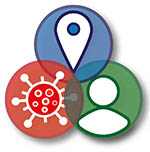
Experiences of working in the public transport sector during the COVID-19 pandemic
The COVID-19 pandemic has significantly affected operations in the public transport sector, and workers in this sector have experienced changes in risk of transmission as well as an array of new and changing operating procedures.
In this blog, Dr Nicola Gartland and Dr Anna Coleman outline the findings from a qualitative study conducted during the second UK national lockdown (Jan – May 2021), investigating perceptions of risk and mitigation among public transport workers, and what impact the sector changes had on worker health and wellbeing.
- The number of people using public transport fell dramatically, fluctuating between 15 – 60% of pre-pandemic levels in the period January – May 2021.
- Most public transport employees reported feeling safe while working, but office-based staff were reported as feeling safer than public-facing staff.
- Mitigation measures during that time were considered to be effective in reducing risk of the virus spreading, although measures may have a detrimental effect on worker morale and wellbeing.
- Understanding the complexities of the pandemic experience is crucial for appropriately designing mitigation strategies and modified working practices that promote employee health and wellbeing.
Drivers (as well as transport workers based in stations, operating and maintaining signal boxes etc.) continued working on site with advised mitigations (for example, face masks, shift bubbles, social distancing, enhanced cleaning etc.) The Government released guidance for operators, workers and passengers to reduce the risk of transmission within the Public Transport sector.
Because of the pandemic and associated guidance, the use of public transport reduced considerably and continues to be lower.
This study formed part of a larger stakeholder engagement with the public transport sector. In the paper, we report on data from semi-structured interviews with public transport organisational leaders and workers carried out between January and May 2021. (Please note, this was a period with very low passenger numbers on public transport.)
We found two overarching themes from the data: (1) perceptions and impacts of risk of COVID-19 for employees; and (2) long-term impacts of COVID-19 on working practices and effects on health and wellbeing.
Perceptions and impacts of risk of COVID-19 and risk mitigations for employees:
Most reported feeling safe generally, but also highlighted circumstances where they felt at higher risk. Office based workers reported feeling very safe, while public-facing workers highlighted more risks, for example, when workers came into close contact with the public, and where risk mitigation measures were not adhered to (e.g., essential travel only, social distancing, face coverings, hand sanitising). Indeed, all participants talked about instances where mitigations were not followed by either colleagues or passengers; non-compliance was described as either wilful/deliberate or a consequence of people feeling safe with one another and forgetting guidance. Most workers on public transport were advised only to ‘encourage’ passengers to wear face coverings; this, and the fact that exemption rules allowed anyone to claim they were exempt, meant that workers were limited in their power to enforce face covering mandates.
Generally, mitigation measures were thought to be effective in reducing the risk of spreading the virus amongst employees, although new procedures and work practices were reported sometimes to have a detrimental effect on worker morale and wellbeing, particularly where they reduced contact between colleagues. Feelings of isolation and reduced job satisfaction were reported where camaraderie between colleagues was lost.
Strong leadership, with a particular emphasis on clear and frequent messaging, was identified as a key part of pandemic management. Regular and clear communication from companies to their employees was viewed positively, and many companies introduced new communication methods to deliver information about new working practices and to enable feedback from workers and contact between workers.
Long-term impacts of COVID-19 on working practices and effects on health and wellbeing:
At the time of the interviews, there was considerable uncertainty about the long-term impact of COVID-19 on working practices. The course of the pandemic was uncertain, but particularly for public transport, the duration of mitigations was unclear. Most participants reported that they expected mitigation measures to remain in place and suggested that their feelings of safety and wellbeing were dependent on this being the case. However, there was also some concern that increasing passenger numbers on public transport would increase risks to workers.
The roll out of the vaccine was seen as a positive progression in the pandemic. However, there was also concern that vaccination would reduce people’s perceptions of risk and result in a decrease in compliance with mitigations which would lead to an increase in risk for public transport workers.
The biggest factor discussed in relation to long-term impact was changes to business structure and wider business viability. Organisational leaders recognised the impact of the wider business on workers’ wellbeing at work. The change in the model of the business, from being funded by passengers to being funded primarily by government grants (during the time of the research), was seen to impact on the working environment and staff morale. Organisational leaders expressed concern for the future viability of the businesses, given uncertainties over the return of passengers to public transport and changes in commuting behaviours. Therefore, this uncertainty and the impact on workers within this sector could be long-term.
Conclusions
While the requirement for mitigations on public transport have now been lifted, our findings are important for understanding how implementation could be improved should mitigations be necessary again in future (for a new wave of COVID-19 or a different public health emergency).
At times when mitigations are necessary, organisations could prevent loneliness and isolation by creating new/alternative ways for employees to have contact. Non-adherence to guidance was felt to be an ongoing source of increased risk although no clear solutions were found. Therefore, it is imperative to understand non-adherence through further research and address this within the workforce. Potentially, interventions could be delivered through organisational messaging to tackle colleague interactions, as well as interactions with the public, and reducing in-group behaviours that can increase risk.
Our research continues, with work ongoing to establish if the same factors that were important earlier in the pandemic are still important, and how perceptions are changing as the pandemic develops. The emergence of the Omicron variant in the UK resulted in further changes being implemented (UK Government Plan B). Since then, all restrictions have been lifted, however, public transport operators still recommend adhering to some mitigations (e.g., face coverings). Transport Focus’ weekly travel surveys show that the wearing of face masks has declined steadily since the removal of the legal mandate. Ongoing research aims to understand how these changing circumstances affect the sector.
A greater understanding of the complexities of the pandemic experience will be vital for appropriately designing modified working practices that promote employee and passenger health and safety as the pandemic continues, as well as futureproofing the sector for ongoing resilience and sustainability.
Read the whole paper published in the Annals of Work Exposure and Health:
This research is part of the PROTECT COVID-19 National Core Study on transmission and environment, funded by HM Treasury and managed by the Health and Safety Executive. The research team also includes Professor David Fishwick, Professor Sheena Johnson, and Professor Martie van Tongeren.






0 Comments